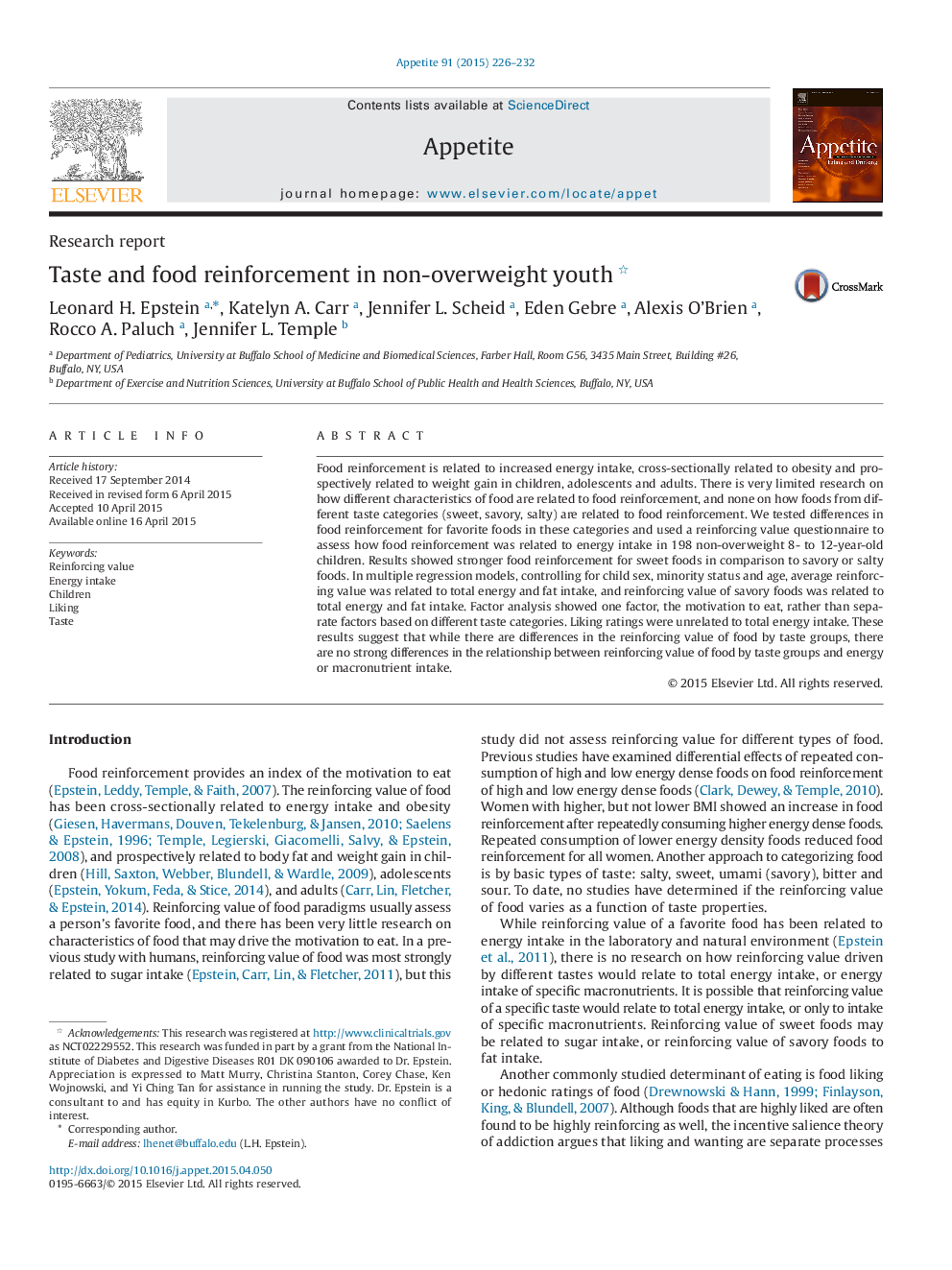| کد مقاله | کد نشریه | سال انتشار | مقاله انگلیسی | نسخه تمام متن |
|---|---|---|---|---|
| 7308734 | 1475389 | 2015 | 7 صفحه PDF | دانلود رایگان |
عنوان انگلیسی مقاله ISI
Taste and food reinforcement in non-overweight youth
ترجمه فارسی عنوان
طعم و تقویت مواد غذایی در جوانان غیر اضافه وزن
دانلود مقاله + سفارش ترجمه
دانلود مقاله ISI انگلیسی
رایگان برای ایرانیان
کلمات کلیدی
تقویت ارزش، مصرف انرژی، فرزندان، عادت ماهیانه طعم
ترجمه چکیده
تقویت مواد غذایی به افزایش مصرف انرژی مربوط می شود، به صورت مقطعی مرتبط با چاقی و به طور چشمگیری با افزایش وزن در کودکان، نوجوانان و بزرگسالان ارتباط دارد. تحقیقات بسیار محدودی در مورد چگونگی ویژگی های مختلف غذا در ارتباط با تقویت مواد غذایی وجود دارد و هیچ کدام در مورد چگونگی مصرف مواد غذایی از گروه های مختلف طعم (شیرین، طعم دار، شور) به تقویت مواد غذایی وجود دارد. ما اختلاف در تقویت غذا برای غذاهای مورد علاقه در این دسته ها را مورد آزمایش قرار دادیم و از یک پرسشنامه ارزش تقویت کننده برای ارزیابی نحوه تقویت مواد غذایی در مصرف انرژی در 198 کودک 8 تا 12 ساله غیر اضافه وزن استفاده شد. نتایج نشان داد تقویت مواد غذایی قوی برای غذاهای شیرین در مقایسه با غذاهای گوشتی یا نمکی. در مدلهای رگرسیون چندگانه، کنترل جنسیت کودک، وضعیت اقلیت و سن، ارزش تقویت متوسط به میزان مصرف کل انرژی و چربی بستگی داشت و ارزش تقویت کننده غذاهای خوراکی مربوط به مصرف کل انرژی و چربی بود. تجزیه و تحلیل عوامل نشان داد که یک عامل، انگیزه برای خوردن، به جای عوامل جداگانه بر اساس دسته های مختلف طعم. ارزیابی های عاطفی مربوط به مصرف کل انرژی بود. این نتایج نشان می دهد که در حالی که در ارزش تقویت غذا توسط گروه های طعم تفاوت وجود دارد، تفاوت های شدیدی در رابطه بین ارزش تقویت غذایی گروه های طعم و مصرف انرژی و یا مغذی ها وجود ندارد.
موضوعات مرتبط
علوم زیستی و بیوفناوری
علوم کشاورزی و بیولوژیک
دانش تغذیه
چکیده انگلیسی
Food reinforcement is related to increased energy intake, cross-sectionally related to obesity and prospectively related to weight gain in children, adolescents and adults. There is very limited research on how different characteristics of food are related to food reinforcement, and none on how foods from different taste categories (sweet, savory, salty) are related to food reinforcement. We tested differences in food reinforcement for favorite foods in these categories and used a reinforcing value questionnaire to assess how food reinforcement was related to energy intake in 198 non-overweight 8- to 12-year-old children. Results showed stronger food reinforcement for sweet foods in comparison to savory or salty foods. In multiple regression models, controlling for child sex, minority status and age, average reinforcing value was related to total energy and fat intake, and reinforcing value of savory foods was related to total energy and fat intake. Factor analysis showed one factor, the motivation to eat, rather than separate factors based on different taste categories. Liking ratings were unrelated to total energy intake. These results suggest that while there are differences in the reinforcing value of food by taste groups, there are no strong differences in the relationship between reinforcing value of food by taste groups and energy or macronutrient intake.
ناشر
Database: Elsevier - ScienceDirect (ساینس دایرکت)
Journal: Appetite - Volume 91, 1 August 2015, Pages 226-232
Journal: Appetite - Volume 91, 1 August 2015, Pages 226-232
نویسندگان
Leonard H. Epstein, Katelyn A. Carr, Jennifer L. Scheid, Eden Gebre, Alexis O'Brien, Rocco A. Paluch, Jennifer L. Temple,
